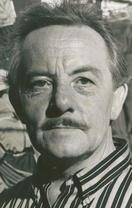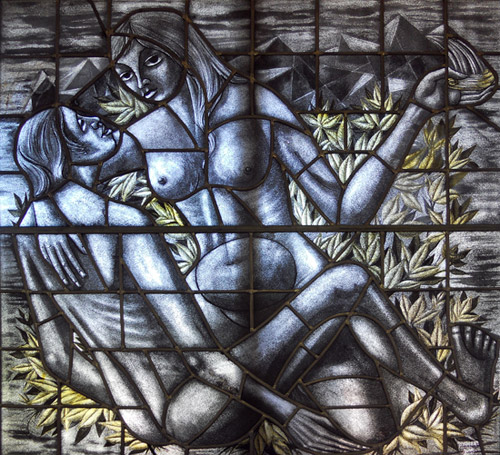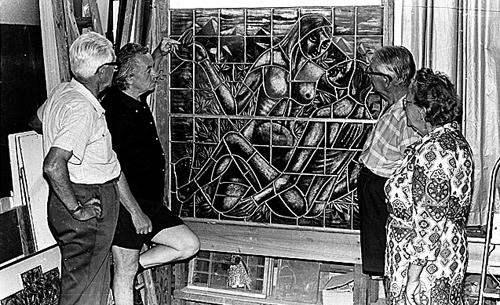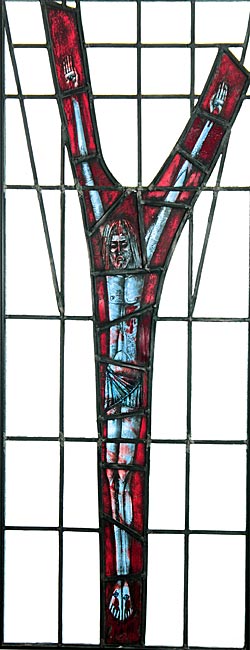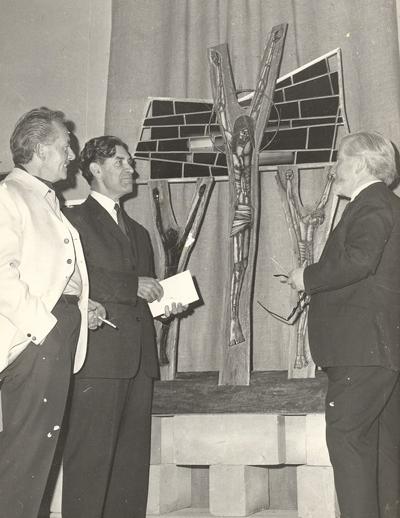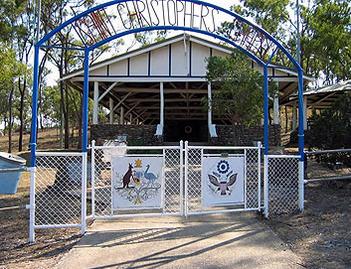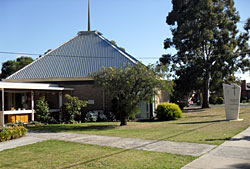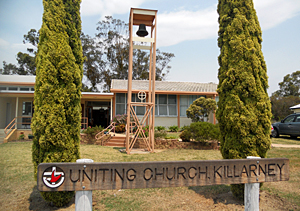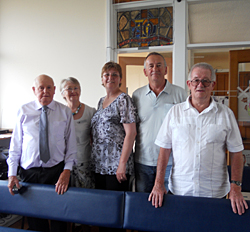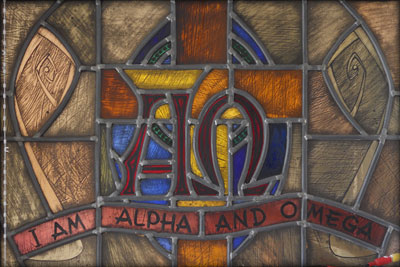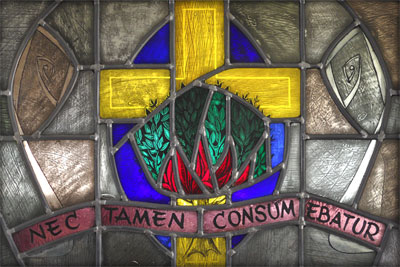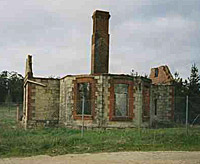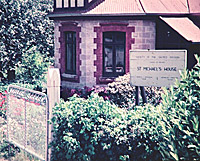All the information contained on this website is from Jean's personal correspondence with his patrons & family,
collated by Noel and Rachael Orval.
Jean made many donations to various churches and businesses throughout his time in Australia, either because of natural disasters or the construction of new buildings. These are just some of them ...
Hygieia - Hamilton Senior Citizens' Club - now Private
Jean made a donation of a glass panel called Hygieia - in Greek mythology the daughter of Asclepius, the God of Medicine. She was the goddess of health, cleanliness and sanitation.
Jean presented this work, valued at $400 to the Hamilton Senior Citizens' Club to place in their new clubrooms when they were built.
At the time, it was thought that the panel was slightly unconventional for its new home, but members received Jean's gift enthusiastically.
President, Mr Graham, wrote Jean to express his "sincere appreciation and gratitude of your magnificent gift to the club of your stained glass window "Hygieia". Believe us that it will be placed in a place of honour in our clubrooms. It is indeed deplorable that an artist of your calibre, after so long a residence here, should be forced to continue your work elsewhere. We wish you success in your new town and sincerely hope that you will get the appreciation and support which your artistry so richly deserves."
Seen admiring the panel is (from left) Mrs Marion Thomas, Mr Ern Bond, Mr Reg Henstridge and Jean.
Since this time, extensive renovations were done and the Senior Citizens decided that they would donate it back to the Orval family and thankfully, it has found it's rightful place with one of Jean's granddaughters.
Crucifix
- Church of the Ascension, East Burwood
Jean offered this Crucifix (originally on a
backing of Red Gum) to the soon to be built
Church of the Ascension in East Burwood
in June of 1968.
The Reverend of the time, Ian Herring, made the journey to Hamilton to see the displays of work in Jean’s studio and was taken with this piece, which he thought because of the novel idea of placing the work onto a fork of Red Gum, “puts Christ into Australia”.
The Anglican Archbishop, Dr Frank Woods, conducted a dedication service on a bleak day in July of 1968 which Jean was able to attend before heading off on his study tour of the Continent shortly thereafter.
Secretary of the Vestry, Mrs Elwin, wrote to Jean to express “the most grateful thanks of the Vestry, and I am sure, of the whole Parish for this fine and most unusual art work which will grace our church when built. At the moment, it is housed in the Vicar’s study, where it has already been admired by so many. Our most sincere thanks for your so generous gift.”
After Jean returned from overseas, he thanked Mrs Elwin and said “I am glad to hear that everyone is pleased with my crucifix. That is pleasing to me and most important - my generosity is not, not to me anyhow.
“I wish I would not have to work to make a living because all I want to do is to make the people happy with my work. Only in this way my work has a meaning to me.”
The church and hall were erected early in 1969, with the church building being dedicated on May 15, 1969. The crucifix was to eventually stand at the church entrance and be given back lighting. Unfortunately over the years for some reason, the wood rotted away and the crucifix was placed onto a clear glass panel.
Golgotha - St Michael's House, Crafers, South Australia
Jean often created new compositions when he had some down time between church and private commissions.
"Golgotha" came to be under these circumstances and he made the offer to donate to St Michael's House because "I could not sell it for any price and rather donate it where I can expect appreciation, than please someone with a bargain, which would be less satisfactory to me.
"The three crosses are very unconventional and the anatomy of the bodies on the crosses are not made to please a surgeon. I wanted it to be Australian as much as I could make it as such. I tried to make it symbolise simplicity, solitary, hardness and at the same time it should look strong, solid, a token of sadness, but a promise of victory. You probably have to be lucky to find that all."
Father Dunstan McKee wrote Jean on February 7, 1969 to express his thanks for the generous gift. "I appreciate very much your remarks about the unconventionality of the work; indeed, am not sure a "conventional" work on your subject would be satisfactory. So I think I could assure you that your work will be appreciated and respected as a work of art in its own right. Some of us are familiar with your work in the Aldgate Church, and have seen other pieces of your work in the possession of the Reverend John Hopton.
"I think all the members of the House who have seen it have been able to appreciate your work, and I personally am very much taken with it."
On February 16, 1983, the Ash Wednesday bushfires ravaged the Mt Lofty Ranges and unfortunately, most of the St Michael's estate was destroyed in the flames. The only part that survived was the refectory, which was constructed in the 1960s. The remainder was a ruin for many years until the whole site was levelled in the 1990s. All that remains now is the shell of the Lodge/gate house, some paths, the old Lime tree and the Californian Oak tree. Many thanks to Robert Elson who provided us with this information, and with the knowledge that "Golgotha" was consumed by the fires as well.
One of Jean's exhibitions at the Hamilton Art Gallery in 1968. This work - Golgotha - was donated to St Michael's House Crafers, South Australia. Pictured with Jean (left) is Dr J. E. Goodyear and the late John Ashworth (right), Director of the Hamilton Art Gallery, who was one of a few who helped others to appreciate the treasure that Jean was.
St Christopher & the Christ Child
- St Christopher's Chapel, Nerimbera, Queensland
One of Jean's outstanding free standing panels was donated to St Christopher's Chapel, Nerimbera (near Rockhampton) in 1968.
The chapel, named after the patron saint of travellers, was built in 1943 by the 542 Engineering Ship and Shore Battalion of the United States Army, which later saw war service in New Guinea and the Philippines.
During peak periods, up to 70,000 servicemen were stationed in the Rockhampton area where Rockhampton was used for "rest periods" in between combat operations.
The building of the chapel for united worship was the idea of two protestant chaplains, a catholic padre and a rabbi who later consecreated the small church at a special service.
When the Americans left, the chapel began to deteriorate, although for a time valuable maintenance work was done by the Rockhampton Beautification Advisory Committee.
After the war, 500 people attended the first commemoration service held on August 10, 1947 and arranged by Presbyterian minister the Reverend J. W. Stewart Lang. Among those present was Mr W. L. Peck, American Consul for Queensland.
Restoration of the unique building began in 1958 when former Master Sergeant Jack Bauman returned to Rockhampton on a visit. He was disappointed at the disrepair of the chapel and sought promises of help from former US servicemen living in the district to paint the chapel if enough money could be raised.
The band rotunda was later erected in recognition of Mr Bauman's efforts to preserve the chapel. Since 1959, a committee formed of RSL and 41st Division US Army has taken over supervision of the chapel. An annual service is held on the Sunday nearest American Independence Day, July 4.
When Jean donated the panel, Mr A. Aitken, secretary of the St Christopher's Chapel Committee said "the panel would provide added interest to the chapel, which was visited annually by thousands of tourists. We believe the maintaining of the chapel and grounds is a worthwhile cause. Much of the furnishing and equipment has been donated and all work in caring for the chapel is voluntary."
St Christopher's Chapel at
Rockhampton is said to be the only
chapel of its kind in the world.
When Jean toured Europe in 1968, he was
told that his St Christopher standing panel
was a unique art form and this medium
had never before been seen in Europe.
This is probably why when Jean was
etched into the annals of the Dutch Lexicon,
it was this photograph of the St Christopher's
panel that was included in his admission.
Killarney Uniting Church, Queensland
In 1968, the Darling Downs town of Killarney was ripped apart by a tornado
which demolished the Presbyterian Church that had stood for 81 years.
Upon hearing of their misfortune through the Church Presbyterian Life, Jean
contacted Mr C. L. Petersen, then Secretary of the Presbyterian Building
Committee, with the offer of a donation of a stained glass window. Jean
forwarded some designs for the Committee's consideration which were then
passed on to Cook & Kerrison & Partners, Architects and Town Planners
of Brisbane.
Jean wrote, "Please don't hesitate to suggest anything you would like changed
in the designs to make the panels according to the architectural style of the building.
I am not the kind or artist who thinks that his work is of more importance than the
building created by the Architect ... all I need is sufficient freedom to make good
windows, nothing more."
On receival of the designs, few alterations were needed and Jean set to work in
between commissions from other churches. By August 18, 1969, the two windows
were completed and then shipped to nearby Warwick by rail.
Mr V. B. Mutch - Sessions Clerk, wrote expressing the appreciation and gratitude of the
congregation, "thanking you very sincerely for the decorative windows donated by you
to our new church. The windows have been installed just above and at the side of the
main entrance door. They set the main entrance off very nicely."
On Sunday, October 21, 2012, the Killarney Presbyterian (now Uniting) Church, celebrated its 125th Anniversary with a service which was attended by Warwick and district parishioners. Rachael, Louis (my brother) and I attended the worship and were treated graciously and greeted with open arms. We shared in a beautiful "country spread" and then took photos of the windows. We would especially like to thank Marg and Ivan (pictured above right), for their help and correspondence which enabled us to complete the story of this most generous donation.


